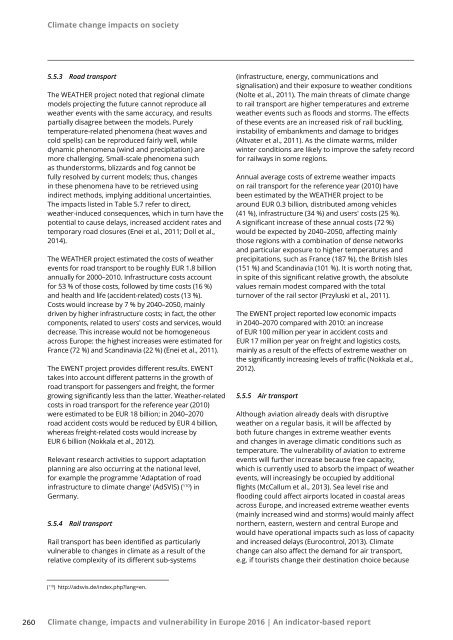Climate change impacts and vulnerability in Europe 2016
document
document
Create successful ePaper yourself
Turn your PDF publications into a flip-book with our unique Google optimized e-Paper software.
<strong>Climate</strong> <strong>change</strong> <strong>impacts</strong> on society<br />
5.5.3 Road transport<br />
The WEATHER project noted that regional climate<br />
models project<strong>in</strong>g the future cannot reproduce all<br />
weather events with the same accuracy, <strong>and</strong> results<br />
partially disagree between the models. Purely<br />
temperature-related phenomena (heat waves <strong>and</strong><br />
cold spells) can be reproduced fairly well, while<br />
dynamic phenomena (w<strong>in</strong>d <strong>and</strong> precipitation) are<br />
more challeng<strong>in</strong>g. Small-scale phenomena such<br />
as thunderstorms, blizzards <strong>and</strong> fog cannot be<br />
fully resolved by current models; thus, <strong>change</strong>s<br />
<strong>in</strong> these phenomena have to be retrieved us<strong>in</strong>g<br />
<strong>in</strong>direct methods, imply<strong>in</strong>g additional uncerta<strong>in</strong>ties.<br />
The <strong>impacts</strong> listed <strong>in</strong> Table 5.7 refer to direct,<br />
weather‐<strong>in</strong>duced consequences, which <strong>in</strong> turn have the<br />
potential to cause delays, <strong>in</strong>creased accident rates <strong>and</strong><br />
temporary road closures (Enei et al., 2011; Doll et al.,<br />
2014).<br />
The WEATHER project estimated the costs of weather<br />
events for road transport to be roughly EUR 1.8 billion<br />
annually for 2000–2010. Infrastructure costs account<br />
for 53 % of those costs, followed by time costs (16 %)<br />
<strong>and</strong> health <strong>and</strong> life (accident-related) costs (13 %).<br />
Costs would <strong>in</strong>crease by 7 % by 2040–2050, ma<strong>in</strong>ly<br />
driven by higher <strong>in</strong>frastructure costs; <strong>in</strong> fact, the other<br />
components, related to users' costs <strong>and</strong> services, would<br />
decrease. This <strong>in</strong>crease would not be homogeneous<br />
across <strong>Europe</strong>: the highest <strong>in</strong>creases were estimated for<br />
France (72 %) <strong>and</strong> Sc<strong>and</strong><strong>in</strong>avia (22 %) (Enei et al., 2011).<br />
The EWENT project provides different results. EWENT<br />
takes <strong>in</strong>to account different patterns <strong>in</strong> the growth of<br />
road transport for passengers <strong>and</strong> freight, the former<br />
grow<strong>in</strong>g significantly less than the latter. Weather‐related<br />
costs <strong>in</strong> road transport for the reference year (2010)<br />
were estimated to be EUR 18 billion; <strong>in</strong> 2040–2070<br />
road accident costs would be reduced by EUR 4 billion,<br />
whereas freight-related costs would <strong>in</strong>crease by<br />
EUR 6 billion (Nokkala et al., 2012).<br />
Relevant research activities to support adaptation<br />
plann<strong>in</strong>g are also occurr<strong>in</strong>g at the national level,<br />
for example the programme 'Adaptation of road<br />
<strong>in</strong>frastructure to climate <strong>change</strong>' (AdSVIS) ( 110 ) <strong>in</strong><br />
Germany.<br />
5.5.4 Rail transport<br />
Rail transport has been identified as particularly<br />
vulnerable to <strong>change</strong>s <strong>in</strong> climate as a result of the<br />
relative complexity of its different sub-systems<br />
(<strong>in</strong>frastructure, energy, communications <strong>and</strong><br />
signalisation) <strong>and</strong> their exposure to weather conditions<br />
(Nolte et al., 2011). The ma<strong>in</strong> threats of climate <strong>change</strong><br />
to rail transport are higher temperatures <strong>and</strong> extreme<br />
weather events such as floods <strong>and</strong> storms. The effects<br />
of these events are an <strong>in</strong>creased risk of rail buckl<strong>in</strong>g,<br />
<strong>in</strong>stability of embankments <strong>and</strong> damage to bridges<br />
(Altvater et al., 2011). As the climate warms, milder<br />
w<strong>in</strong>ter conditions are likely to improve the safety record<br />
for railways <strong>in</strong> some regions.<br />
Annual average costs of extreme weather <strong>impacts</strong><br />
on rail transport for the reference year (2010) have<br />
been estimated by the WEATHER project to be<br />
around EUR 0.3 billion, distributed among vehicles<br />
(41 %), <strong>in</strong>frastructure (34 %) <strong>and</strong> users' costs (25 %).<br />
A significant <strong>in</strong>crease of these annual costs (72 %)<br />
would be expected by 2040–2050, affect<strong>in</strong>g ma<strong>in</strong>ly<br />
those regions with a comb<strong>in</strong>ation of dense networks<br />
<strong>and</strong> particular exposure to higher temperatures <strong>and</strong><br />
precipitations, such as France (187 %), the British Isles<br />
(151 %) <strong>and</strong> Sc<strong>and</strong><strong>in</strong>avia (101 %). It is worth not<strong>in</strong>g that,<br />
<strong>in</strong> spite of this significant relative growth, the absolute<br />
values rema<strong>in</strong> modest compared with the total<br />
turnover of the rail sector (Przyluski et al., 2011).<br />
The EWENT project reported low economic <strong>impacts</strong><br />
<strong>in</strong> 2040–2070 compared with 2010: an <strong>in</strong>crease<br />
of EUR 100 million per year <strong>in</strong> accident costs <strong>and</strong><br />
EUR 17 million per year on freight <strong>and</strong> logistics costs,<br />
ma<strong>in</strong>ly as a result of the effects of extreme weather on<br />
the significantly <strong>in</strong>creas<strong>in</strong>g levels of traffic (Nokkala et al.,<br />
2012).<br />
5.5.5 Air transport<br />
Although aviation already deals with disruptive<br />
weather on a regular basis, it will be affected by<br />
both future <strong>change</strong>s <strong>in</strong> extreme weather events<br />
<strong>and</strong> <strong>change</strong>s <strong>in</strong> average climatic conditions such as<br />
temperature. The <strong>vulnerability</strong> of aviation to extreme<br />
events will further <strong>in</strong>crease because free capacity,<br />
which is currently used to absorb the impact of weather<br />
events, will <strong>in</strong>creas<strong>in</strong>gly be occupied by additional<br />
flights (McCallum et al., 2013). Sea level rise <strong>and</strong><br />
flood<strong>in</strong>g could affect airports located <strong>in</strong> coastal areas<br />
across <strong>Europe</strong>, <strong>and</strong> <strong>in</strong>creased extreme weather events<br />
(ma<strong>in</strong>ly <strong>in</strong>creased w<strong>in</strong>d <strong>and</strong> storms) would ma<strong>in</strong>ly affect<br />
northern, eastern, western <strong>and</strong> central <strong>Europe</strong> <strong>and</strong><br />
would have operational <strong>impacts</strong> such as loss of capacity<br />
<strong>and</strong> <strong>in</strong>creased delays (Eurocontrol, 2013). <strong>Climate</strong><br />
<strong>change</strong> can also affect the dem<strong>and</strong> for air transport,<br />
e.g. if tourists <strong>change</strong> their dest<strong>in</strong>ation choice because<br />
( 110 ) http://adsvis.de/<strong>in</strong>dex.php?lang=en.<br />
260 <strong>Climate</strong> <strong>change</strong>, <strong>impacts</strong> <strong>and</strong> <strong>vulnerability</strong> <strong>in</strong> <strong>Europe</strong> <strong>2016</strong> | An <strong>in</strong>dicator-based report


